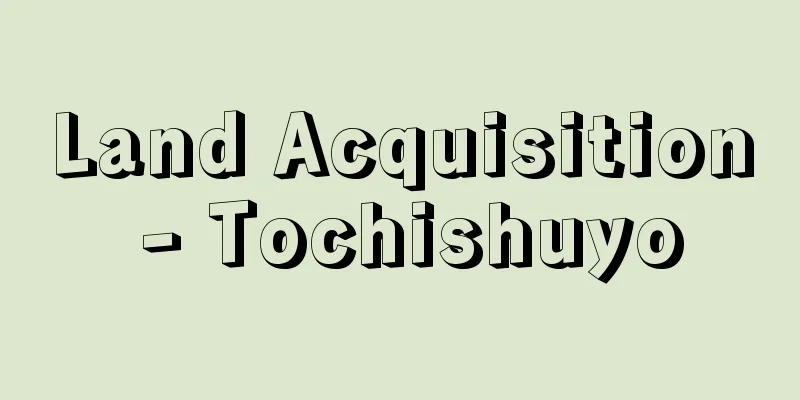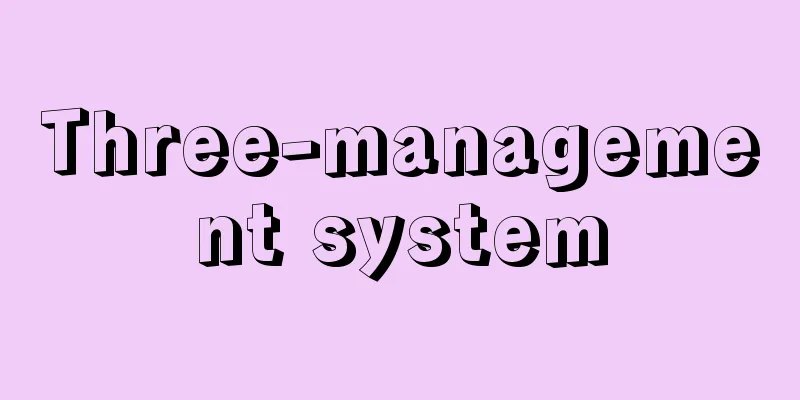Land Acquisition - Tochishuyo

|
Compulsory acquisition of land, etc., from owners, etc., necessary for public works. Based on Article 29, Paragraph 3 of the Constitution, which states that private property may be used for public purposes with fair compensation, the Land Expropriation Act (Law No. 219 of 1951) stipulates the requirements, procedures, effects, and compensation for losses in order to harmonize the execution of public works and the protection of private property. Projects eligible for land expropriation (projects eligible for expropriation) are limited to those listed in Article 3 of the same Act, projects related to the development of urban planning facilities as stipulated in the City Planning Act, and urban development projects (land readjustment projects, urban redevelopment projects, etc.) (Article 69 of the City Planning Act), and land expropriation cannot be carried out for projects other than these. Originally, it was a system for acquiring land for public works projects (roads, parks, schools, rivers, high-voltage lines, railways, etc.), and the land in question was ultimately used for public purposes. However, after the project was completed, such as the development of housing complexes and industrial parks, the land was transferred or leased to private individuals, and even these private uses are considered eligible for expropriation because they contribute to the creation of better cities (public private expropriation). Being a business eligible for expropriation only qualifies it in the abstract for expropriation. Specifically, whether a business has sufficient public benefit to expropriate land is determined by the Minister of Land, Infrastructure, Transport and Tourism or the prefectural governor through a business certification system. This involves examining the will and ability to carry out the business, the appropriateness and rationality of the land use, and the public interest necessity of land expropriation. Once business certification is granted, the promoter (expropriator) can investigate the land property and apply for a ruling from the expropriation committee established in the prefecture. There are two types of rulings: rights acquisition rulings and eviction rulings. The former rulings determine the area of the land to be expropriated, as well as compensation for losses for rights other than ownership of the land or land, and the timing of the acquisition of rights. The latter rulings determine the handover of the expropriated land, removal of the property, and compensation for losses associated with these, and determine compensation for losses other than rights acquisition rulings and the timing of eviction. When a rights acquisition decision is made and the developer fulfills the compensation obligation by the time of rights acquisition set by the decision, the developer acquires land ownership etc. at the time of rights acquisition, and all rights and restrictions that are incompatible with this are extinguished. When an eviction decision is made, the person occupying the land or the property on said land must hand over the expropriated land to the developer by the time of eviction, and relocate any property that does not need to be expropriated outside the expropriated land. If this obligation is not fulfilled, the developer may request execution by the mayor of the city, town or village or the prefectural governor. The remedies available to those who are dissatisfied with the decision of the expropriation committee vary depending on whether the decision is for a public interest matter regarding the area of the land to be expropriated or for a private interest matter regarding compensation for losses. In the former case, the Minister of Land, Infrastructure, Transport and Tourism can request a review or file a lawsuit to set aside the decision. In the latter case, the request for review is not allowed as it is a private matter between the promoter and the landowner, and the landowner and promoter will fight it out (formal party lawsuit). The former must be filed within three months from the date of receiving the original copy of the decision, and the latter within six months. The "Special Measures Law Concerning the Acquisition of Land for Public Use" (Law No. 150 of 1961) provides for special provisions in the Land Expropriation Law for specific public works projects that are particularly important to the public interest, such as certain national expressways or national highways, certain important sections of railways, and important airports (Narita International Airport, Tokyo International Airport, Kansai International Airport, and Chubu Centrair International Airport), in order to ensure the smooth execution of the projects. In addition, the public interest of the project was considered to have been settled at the project certification stage, and the expropriation committee did not have to consider it in principle, but in reality, claims that the project did not have public interest were made at the expropriation committee's review stage, which led to confusion in the review. Therefore, the amendment to the Land Expropriation Act in 2001 (Heisei 13) made it necessary to hear the opinions of the Social Capital Development Council and other bodies at the project certification stage and to respect those opinions (Land Expropriation Act, Articles 25-2 and 34-7), in an attempt to ensure the objectivity of project certification, but made it clear that the expropriation committee could submit a written opinion regarding compensation for losses to the extent that its own rights were affected, but could not assert dissatisfaction with the project certification (Land Expropriation Act, Articles 43, Paragraphs 2 and 3). However, in a lawsuit to annul the expropriation, even if a lawsuit to annul the project certification has not been filed, it is possible to assert the illegality of the project certification. This is because the illegality of the expropriation decision is interpreted as inheriting the illegality of the project certification on which it is based (succession of illegality). [Yasuhito Abe] [Reference items] | | | | | | | | | | |Source: Shogakukan Encyclopedia Nipponica About Encyclopedia Nipponica Information | Legend |
|
公共事業のために必要な土地等を所有者等から強制的に取得すること。私有財産は正当な補償の下に公共のために用いることができるとする憲法第29条第3項に基づき土地収用法(昭和26年法律第219号)が、公共事業の遂行と私有財産の保障を調和させるため、その要件、手続、効果、損失補償を定めている。土地収用をする資格のある事業(収用適格事業)は、同法第3条に列記されているものと、都市計画法に定める都市計画施設の整備に関する事業、および市街地開発事業(土地区画整理事業、市街地再開発事業等)に限られ(都市計画法69条)、これ以外の事業ではそもそも土地収用はできない。もともとは公共事業の用地を取得するための制度であって(道路、公園、学校、河川、高圧線、鉄道など)、当該土地は最終的には公共の用に供されていたが、その後、住宅団地や工業団地の造成事業のように事業完成後は私人に譲渡または賃貸され、その私的な利用に供されるものも、よりよい街づくりに寄与するという理由で収用適格事業とされている(公共的私的収用)。 収用適格事業であるというだけでは抽象的に収用する資格があるというにとどまる。具体的に当該事業が土地を収用するに足るだけの公益性を有するかどうかは、事業認定の制度で国土交通大臣または都道府県知事が判断する。これは事業遂行の意思と能力、土地利用の適正かつ合理性、土地収用の公益上の必要性を審査する。事業認定がなされると、起業者(収用者)は土地物件を調査し、都道府県に置かれる収用委員会に裁決を申請することができる。裁決には権利取得裁決と明渡裁決がある。前者は、収用する土地の区域のほか、土地または土地に関する所有権以外の権利に対する損失補償および権利取得の時期について裁決する。後者は、収用する土地の引渡し、物件の収去およびこれに伴う損失補償についてする裁決で、権利取得裁決以外の損失補償と明渡しの時期について裁決される。権利取得裁決がなされ、起業者が裁決で定められた権利取得の時期までに補償義務を履行したときは、起業者は権利取得の時期において土地所有権等を取得し、これと両立しない権利および拘束はすべて消滅する。明渡裁決があると、土地または当該土地にある物件を占有している者は、明渡しの時期までに、起業者に収用された土地を引き渡し、収用する必要のない物件を収用地外に移転しなければならない。その義務の履行がないときは、起業者は市町村長または都道府県知事に対して代執行を請求することができる。 収用委員会の裁決に不服のある者の救済方法は、収用する土地の区域に関する公益的裁決事項と、損失補償に関する私益的裁決事項により異なる。前者は、国土交通大臣に対して審査請求をすることもできるし取消訴訟を提起することもできる。後者は、起業者と土地所有者の間の私的事項であるとして審査請求を認めず、土地所有者と起業者の間で争う(形式的当事者訴訟)ことになる。裁決書の正本の送達を受けた日から前者は3か月以内に、後者は6か月以内に提起しなければならない。なお、「公共用地の取得に関する特別措置法」(昭和36年法律第150号)では、特定の高速自動車国道または一般国道、鉄道のうち一定の重要な区間、重要な空港(成田国際空港、東京国際空港、関西国際空港、中部国際空港)など、公共の利害にとくに重大な関係のある特定公共事業について、事業の円滑な遂行のため土地収用法の特例を定めている。 なお、事業の公益性については、事業認定の段階で決着がついたものとして、収用委員会では審理しないたてまえであったが、現実には収用委員会の審理段階で、事業の公益性がないとの主張がなされて、審理が混乱することがあった。そこで、2001年(平成13)の土地収用法改正により、事業認定段階であらかじめ社会資本整備審議会等の意見を聴き、その意見を尊重しなければならない(土地収用法25条の2、34条の7)として、事業認定の客観性を確保しようとするかわりに、収用委員会では、損失の補償に関して自己の権利が影響を受ける限度で意見書を提出することができるものの、事業認定に関する不服を主張することはできない(同法43条2項、3項)ことが明示された。 ただし、収用されたあとの取消訴訟では、事業認定の取消訴訟を提起していなくても、事業認定の違法を主張することができる。これは、収用裁決の違法性が、その前提となる事業認定の違法性を承継したもの(違法性の承継)と解されるためである。 [阿部泰隆] [参照項目] | | | | | | | | | | |出典 小学館 日本大百科全書(ニッポニカ)日本大百科全書(ニッポニカ)について 情報 | 凡例 |
<<: Land Condition Map - Tochigi Prefecture
Recommend
Giant Two-banded Wasp - Giant Two-banded Wasp
...The Japanese wasp Euodynerus notatus nipanicus...
The Realm of Hungry Ghosts
〘Noun〙 A Buddhist term. One of the five or six pat...
Skydiving - Skydiving (English spelling)
A sport that uses a parachute. Competitors compet...
Kyoritsu Women's Vocational School
…It was approved as a school corporation in 1951....
Yorkshire
A region in the northeast of England, United Kingd...
Ferdinand Hodler
Swiss painter. Born into a joiner's family in...
laura
...His Coptic rule was soon translated into Greek...
Constitution Act, 1867-1982
…Official name: CanadaArea: 9,976,100 km2Populati...
erfiöl (English spelling) erfiol
…The cost of the heir's feast is also a symbo...
Asclepius
…The ancient Hermetic texts were apparently enorm...
Wisteria (Fuji) - Wisteria floribunda; wisteria
A creeping shrub of the legume family, also known ...
Keisai Asami
A Confucian scholar from the mid-Edo period. His ...
Egas, E. (English spelling) EgasE
…Facing the main square, there is a cloister (16t...
Cominform - Cominform (English spelling)
Abbreviation for the Communist Information Bureau...
Sacheon
A port city in the southwestern tip of South Gyeon...







![Gohira [town] - Aira](/upload/images/67cacf6776d5c.webp)

